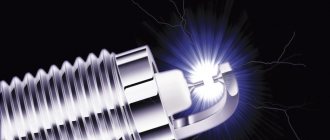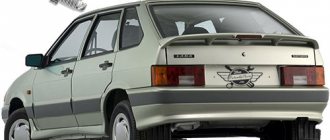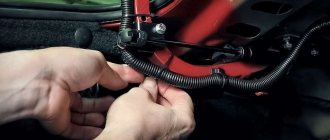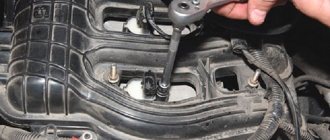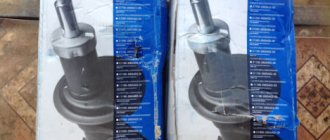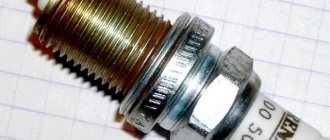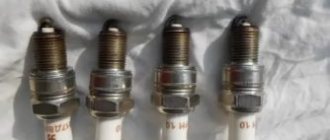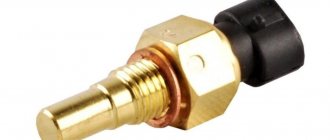Spark plugs for Lada Vesta 1.6 and 1.8 are needed to ignite the fuel and if one or more of them stop working, this will affect the stability of the car. Proper and maintenance is required. It is important to pay close attention to the operation of the engine and its ignition system. In most modern 1.6 and 1.8 engines, flammable mixtures are ignited using an electric charge. It passes between the copper or nickel electrodes of the spark plugs.
Worn igniters cause serious technical problems:
- significant reduction in engine power;
- excess fuel consumption;
- catalyst overheating;
- detonation (explosive nature of fuel combustion).
Replacing spark plugs on a Lada West on time helps the car's engine run longer and more efficiently. According to the technical recommendations of the AVTOVAZ company, replacing spark plugs in a Lada Vesta car should be done every 30,000 km. Car owners note that ignition devices do not fail so quickly. Given the difficult practical operating conditions of the car, it is better to adhere to the rule of frequent replacement.
We will indicate signs of wear on the ignition system elements and tell you how to replace the elements yourself.
Changing spark plugs on Lada Vesta - instructions
Draw your attention to! All work must be performed on a cold engine. Firstly, this contributes to your safety - you won’t get burned on a cold engine. Secondly, spark plugs expand when the engine is hot, making them difficult to unscrew. And if you apply excessive force, you can completely break the thread.
1. Open the hood and remove the plastic engine cover.
2. Directly under the plastic trim we see a wiring harness that controls the ignition coils. Press the latch on the wire chip and remove it from the connector. We perform a similar procedure with the three remaining wires.
3. Using a 10″ socket, one by one, unscrew the 4 bolts securing the ignition coils and remove the coils.
4. Use a 16″ high socket or a special spark plug wrench to remove the spark plugs.
A little advice! If the spark plug remains in the spark plug well, it can be pulled out using a reel. We just put a coil on the candle and lift it up.
5. Next, you need to screw the new spark plugs into place. You need to wrap it without force and always by hand. If you feel force, it means the spark plug is not following the thread. Be sure to unscrew it completely, clean the threads and screw it back on.
Advice! Before wrapping the spark plug, it is recommended to lubricate the threads with a special high-temperature lubricant. This will prevent damage to the thread when unscrewing the spark plug.
The last step is to put everything back in place in reverse order and enjoy the work done.
Reviews
| № | Positive |
| 1 | Andrey (Avtodrom): two years have passed since I bought the car, I haven’t changed the spark plugs yet, the engine is running stably. The default ones are factory installed – Brisk, I’m happy with the quality. |
| 2 | Sergey (Avtotema): I have 16 valves. motor, replaced the igniters at a mileage of 25,000 km. Comrades advised with an iridium electrode. |
| 3 | Kirill (Autoreview): I regularly change spark plugs every two years. There are no complaints about the motor. |
| 4 | Alexey (Avtoria): I bought a used Lada Vesta, the previous owner installed Finwhale. There are no comments on the operation of the engine, fuel consumption is within normal limits. |
| 5 | Alexander (Drom): my positive review of NGK. The price is steep, but the workmanship and durability are pleasantly surprising. |
| 6 | Stanislav (Driving): I have no problems with the car, the mechanisms are working normally. The main thing is to strictly adhere to the deadlines for scheduled technical inspections. |
| 7 | Vasily Alekseevich (“5th wheel”): I buy NGK spark plugs, the service life is at least 45 - 50 thousand km. Draw conclusions. |
| Negative | |
| 8 | Vitaly (Avtotema): the original spark plugs did not last long, only 25,000 km. I decided to install Finwhale, I heard numerous positive reviews. |
| 9 | Svyatoslav (Otzovik.net): I change igniters on my own, I don’t turn to the service station for help. |
| 10 | Vlad (ProAuto): I heard about the unstable operation of spark plugs on the Lada Vesta before buying the car. Immediately replaced it with Bosch, second year of active use without any comments. |
Fresh ignitions: installation recommendations and purpose
Before you begin to study the method of replacing spark plugs in a Lada Vesta, you should find out what function they carry, and which spark plugs are installed on the model of the Russian automobile industry we are discussing. Spark plugs are needed to ignite the air-fuel mixture in the engine. The operation of the engine and other indicators will depend on the condition of the spark plugs:
- Fuel detonation;
- High fuel consumption;
- Power unit power;
- The catalytic converter overheats;
- The catalytic converter fails.
In general, replacement of spark plugs is necessary when there is a malfunction. If their condition is bad, then the engine is in the same condition. For example, oil marks on the threads or electrodes will tell you that the oil reflective caps are faulty.
Important The manufacturer indicates that replacement should be made every 30 thousand kilometers. Experts say that candles can last much longer. In this case, all operating instructions must be observed. The service life of spark plugs is reduced due to difficult operating conditions of the machine, low-quality fuel, and so on. You should always remember about timely replacement, which will protect the driver from troubles that may arise during the trip. The automotive industry recommends that all buyers of their cars install spark plugs that are compatible with a specific model. All types of candles are listed in the table below:
You can purchase candles easily and simply through specialized stores. One candle for the Russian Lada Vesta will cost between 60-1000 rubles. Accordingly, the cost depends on the material from which it is made and the manufacturer, plus some design features.
The car owner himself decides which products to install. There is now a lot of information available about the use of iridium and multielectron cells. If you delve into the topic and study the opinions of car owners who use different options in the ignition system of their cars, during operation they do not see any difference between such spark plugs. It must be remembered that cheaper ones will have to be changed more often. Also, iridium options must be installed and all recommendations of the automobile manufacturer must be followed.
Obvious signs of wear - you need to know
Spark plugs are a device for igniting gasoline. Lada Vesta is equipped with a 16-valve engine, that is, a spark plug set of 4 units is required.
We list the main signs that the spark plugs on a Lada Vesta need to be changed:
1. The starter operates with a delay, after several idle revolutions; 2. The ride of the car is not smooth, but with noticeable jerks; 3. Motor dynamics decrease; 4. Fuel consumption per 1 sq. km increases; 5. The color of the exhaust gases changes.
Sometimes the condition of the ignition device can indicate problems with other parts of the vehicle. For example, if the thread of the spark plug hole contains traces of oil on the electrodes, this means: the oil reflective caps have exhausted their service life. The service station staff will advise you when to replace the igniters. However, this period is also determined by the brand, and it can be found out from the factory operating instructions.
Spark plug sets for the 16-valve Lada Vesta are produced by different companies - both Russian and foreign.
Let's sum it up
Now you know how to change spark plugs on any Vesta engine. There are no difficulties in this matter. You can do everything yourself, you just need to follow the installation instructions and make replacements in a timely manner.
We replace spark plugs on a cooled engine. Remove the plastic protection from the engine.
2/8
Press the plastic retainer and remove the connector.
3/8
We unscrew the mounting screw on the ignition coil with the E-8 head and remove the coil itself from the spark plug well.
4/8
Remove the coil from the spark plug well.
5/8
Then we unscrew the spark plug itself with a high head (preferably with an extension) 16 mm or a special spark plug wrench.
6/8
We take out the spark plug.
7/8
We take new spark plugs and begin installation. We screw the spark plug in by hand to avoid damaging the threads of the spark plug hole in the cylinder head. Next, tighten the spark plug to a torque of 25–30 Nm.
8/8
Then we put the coil back into the spark plug well. We fix the block to the connector using a clamp. The procedure can be considered completed.
—>
Lada Vesta can be equipped with one of two engines: VAZ-21129 and VAZ-21179 with working volumes of 1.6 and 1.8 liters (power 106 hp and 122 hp, respectively). But the candles that go with them are the same, so there is no fundamental difference. During the preparation of the car for routine maintenance, replacement of spark plugs of a LADA Vesta with a VAZ-21129 engine (106 hp) is indicated.
Collection of technological instructions lada vesta
07 May 2022 Lada.Online 87 883
The article presents manuals for the maintenance and repair of the Lada Vesta car. The collection of instructions is intended for specialists and engineering workers of enterprises involved in the sale, maintenance and repair of LADA cars, and can be used in personnel training.
| vendor code | Name | Availability in the archive |
| TI 3100.25100.10035 | Hub with brake disc assembly for front-wheel drive LADA cars - measuring runout on the car | Link |
| TI 3100.25100.10050 | Lada Vesta cars and its modifications - pre-sale preparation | Link |
| TI 3100.25100.12055 | Automated manual transmission control system for Lada Vesta cars - fault diagnosis | Yes |
| TI 3100.25100.12056 | Electronic engine control system 21129 for LADA Vesta family vehicles with M86 Euro-5 controller - design and diagnostics | Yes |
| TI 3100.25100.12057 | Car access control system LADA Vesta-device, fault diagnosis | Yes |
| TI 3100.25100.12058 | Anti-lock braking system ABS 9.1 and electronic stability control system for Lada Vesta and Lada XRAY cars - fault diagnosis | Yes |
| TI 3100.25100.12059 | Central unit of body electronics for Lada Vesta, Lada Xray cars – device, fault diagnosis | Yes |
| TI 3100.25100.12061 | Functional description and diagnostics of the EMM system | Yes |
| TI 3100.25100.12063 | CNG power system of Lada Vesta cars - design and fault diagnosis | Link1 Link2 |
| TI 3100.25100.12064 | Emergency response system for Lada Vesta car accidents - design and fault diagnosis | Yes |
| TI 3100.25100.12065 | Airbag system for Lada Vesta cars - design and fault diagnosis | Link |
| TI 3100.25100.12066 | Automatic climate control system for Lada Vesta cars - fault diagnosis | Link |
| TI 3100.25100.12067 | Electromechanical power steering for Lada Vesta cars - design and fault diagnosis | Link |
| TI 3100.25100.12068 | Block of additional functions of body electronics of Lada Vesta cars - fault diagnosis | Link |
| TI 3100.25100.12070 | The control system of the continuously variable transmission (CVT) “jatco” of the Lada XRAY car – device, principle of operation, diagnostics | Yes |
| TI 3100.25100.12072 | Instrument cluster of Lada Vesta cars - fault diagnosis | Link1 Link2 |
| TI 3100.25100.13070 | LADA cars – checking and adjusting wheel alignment angles. | Link |
| TI 3100.25100.20582 | LADA VESTA car engine - removal/installation of main systems, components and parts | Yes |
| TI 3100.25100.20583 | Transmission of the LADA Vesta car - removal/installation, disassembly/assembly of main components and parts | Yes |
| TI 3100.25100.20584 | Front, rear and wheel suspensions - removal/installation, disassembly/assembly of main components and parts | Yes |
| TI 3100.25100.20585 | Steering - removal/installation of main components and parts | Yes |
| TI 3100.25100.20586 | Brake system of LADA Vesta car - removal/installation of main components and parts | Yes |
| TI 3100.25100.20587 | Electrical equipment of the LADA VESTA car - removal/installation of main components and parts | Yes |
| TI 3100.25100.20589 | Lada Vesta car body - removal and installation of main components and parts | Yes |
| TI 3100.25100.20590 | Climate system of LADA Vesta car - device, maintenance, troubleshooting, removal and installation of main components and parts | Yes |
| TI 3100.25100.20603 | Lada Vesta CNG car - removal and installation of original components and parts | Link1 Link2 Link3 Link4 |
| TI 3100.25100.20605 | Original body parts of the Lada Vesta SW car - removal and installation | Yes |
| TI 3100.25100.20606 | Original body parts of the LADA VESTA CROSS car - removal and installation | Yes |
| TI 3100.25100.20612 | Original body parts of the Lada Vesta Sport car - removal and installation | Link |
| TI 3100.25100.21013 | Lada Vesta car seats - disassembly/assembly | Link |
| TI 3100.25100.27059 | Additional equipment for LADA cars. Towbar - installation | Link |
| TI 3100.25100.27061 | Modification of intake module 21127-1008600 for installation on Lada Vesta CNG and Lada Largus CNG cars with gas equipment. | Link |
| TI 3100.25100.40206 | H4Mk Engine – Repair | Yes |
| TI 3100.25100.40207 | Engine VAZ-21179 – Repair | Link |
| TI 3100.25100.40209 | External rear view mirror of Lada Vesta car - disassembly / assembly | Link1 Link2 Link3 |
| TI 3100.25100.87018 | LADA VESTA car – anti-corrosion treatment of closed cavities, bottom and wheel arches | Link |
| TI 3100.25100.87020 | LADA cars – anti-corrosion treatment of closed cavities, underbody and wheel arches | Link |
Documentation in electronic form can be downloaded in PDF format by all site users:
Attention! You do not have permission to view hidden text.
The article will be updated as missing collections with technological instructions are added. We hope for help from users.
See other useful instructions:
Share on social networks:
Found an error? Select it and press Ctrl Enter..
Guests cannot leave comments in the news, please log in.
What spark plugs to install and their price
The Lada Vesta VAZ-21129 engine uses original AU17DVRM spark plugs, where:
Table “
”
| Decoding the markings of the original Vesta candle | ||||||
| Thread M14 x 1.25: | Hexagonal part of the housing with a “16 mm” key: | Heat number: | Thread length 19mm, flat seat: | Protrusion of the thermal part of the insulator cone: | Built-in resistor: | Bimetallic center electrode: |
| A | U | 17 | D | IN | R | M |
Standard domestic spark plugs are just enough for the intended period, but as noted by car owners, after half the service life, difficulties may arise when starting the engine in cold weather. Spark plugs produced by foreign manufacturers will be a worthy replacement:
Bosch - 0242235913. Price per set is 400 rubles. The cost of one such candle 0241235751 is 120 rubles. You can also find it cheaper, of the same brand, only Russian-made Bosch 0242235666 “Super plus” spark plug. Price – 80 rub./piece.
Yttrium F01H7B0146, a kit from this company will cost 220 rubles.
Spark plugs from more famous manufacturers such as Denso , spark plug “Nickel” Q20PRU11 and spark plug from NGK , product code 2330, will cost 100 rubles per piece. Spark plugs from the expensive price segment such as “Longlife” from VAG (made in Germany) product code 101905601F will cost 350 rubles/piece.
Many motorists advise purchasing spark plugs produced using new technologies. These innovations include iridium spark plugs. On the market they are represented by “Iridium Power” spark plugs from Denso, product code IK20TT, price 560 rub./piece.
But installing such expensive spark plugs on a domestic car is simply unprofitable.
If you find oil in the spark plug wells
The Lada Vesta has an unpleasant flaw. Insufficiently reliable sealing of the engine between the valve cover and the cylinder head. Because of this, oil gets into the spark plug wells. The problem can be fixed at the dealer under warranty - you just need to re-glue the camshafts and reliably seal the engine. Or contact a service station.
The problem occurs on cars where the manufacturer does not provide gaskets in the classical sense. An anaerobic sealant is used, which seals the cylinder head, camshaft bed and valve cover together.
In this case, given the inconsistent build quality of AvtoVAZ, there is a problem with the seal of the planes connecting in the upper part of the cylinder head. And since the oil pressure in the cylinder head is quite high (about 3-4 bar), the oil begins to flow into the spark plug wells
What are the dangers of oil getting into spark plug wells?
Due to oil leakage, the spark plugs and ignition coil fail faster. The spark plugs and coil do not break immediately after oil gets on them. But over time, the parts will fail - they are not designed to work in such conditions.
Many drivers note that due to oil in the spark plug wells, the engine begins to stall. It may also be harder to start. This is especially true during the cold season.
Damage to spark plugs, ignition coils and overall engine load depend on operating conditions. Many drivers who use their cars in a gentle mode only find out about an oil leak when replacing the spark plugs.
Until this moment, the malfunction does not cause discomfort. If the driver likes to drive aggressively, then the working life of the spark plugs, ignition coil and engine is noticeably reduced.
Replacing spark plugs on a Lada Vesta with your own hands
To carry out the work, you will need a 16 mm spark plug wrench with an extension and a special head with a rubberized coupling built into it, with which the spark plug is held, and a flat-blade screwdriver.
- We take out the ignition coil of the first cylinder.
- Using a 16mm socket wrench for spark plugs, unscrew the spark plug and remove it from the seat.
- Remove the spark plug from the key.
- Using a round feeler gauge, measure the gap on the spark plug electrode. If necessary, we adjust the gap by bending it. When checking the gap with flat feeler gauges, remember that it should be 1.0-1.15 mm.
- We install the spark plug in the head of the key and screw it into the seat.
- We carry out similar actions on the remaining cylinders. To prevent the threads in the cylinder head from breaking, you must first tighten the spark plug by hand. And only then, using a torque wrench and an extension, screw it into the spark plug well with a tightening torque of 30-40 Nm.
- Perform the above operations on other cylinders.
Diagnostic information.
The M86 controller constantly monitors the current through the ignition coil. If there is no current or its insufficient value, a fault code is recorded.
Similar articles:
- Operating manual for GAZelle Next LPG A21R25, A21R35, A22R35, A31R25, A32R25, A31R35, A32R35 cars and GAZelle Next LPG A63R45, A64R45, A65R35 buses.
- Operating manual for Gazelle Business Diesel GAZ-3302, GAZ-2705, GAZ-3221 with Cummins ISF2.8 diesel engines, 3302-3902021-30 RE.
- The reasons for the formation of ice in a car battery, the freezing point of the electrolyte, the voltage and density of the electrolyte, what to do with a battery that has ice in the jars.
- Why you can’t drain the electrolyte by turning a car battery over, shorting the electrode blocks in the battery banks with sludge.
- Causes of car battery explosion, gas formation, electrolyte level, causes of spark formation.
- Warranty period and service life of a car battery, the difference between the warranty period and the service life or technical resource of a car battery.
General tips for connecting high-voltage wires.
Laying wires. Do not try to connect the wires in a bundle. Disassemble the wiring harnesses, release the wires from the plastic holders. Connect the high-voltage leads to the corresponding cylinder spark plugs. Lay the wires so that they do not rub against each other, engine parts, or hoses. Avoid sharp bends and tension on the wires. After connecting all the wires, secure them into the bundle with special comb holders included in the delivery kit.
The procedure for connecting I/O wires to a VAZ carburetor (2108, 2109, 21099)
The central wire from the distributor cover always goes to the ignition coil (bobbin).
The outlet of the distributor cover, which faces towards the front of the car, is connected to the first cylinder.
The outlet of the distributor cap, looking down, is connected to the third cylinder.
The outlet of the distributor cap, looking rearward, is connected to the fourth cylinder.
The outlet of the distributor cap, looking up, is connected to the second cylinder.
The procedure for connecting high-voltage wires to a VAZ Classic, Niva with a carburetor and distributor.
Central wire from the ignition coil (bobbin)
Injection VAZ produced before 2004 with an old-style ignition module (4-pin low-voltage connector)
Injection VAZ produced after 2004 with a new ignition coil (3-pin low-voltage connector)
As with the old-style ignition modules, the new coils are also marked with pins corresponding to the cylinders. But the connection order is different from the order on the old-style ignition module. Be careful.
On VAZ 2105, 2107 cars a contact (battery) ignition system is installed. Contact, since the operation of the entire system is based on the opening and closing of the breaker contacts in the distributor. Unlike a similar contact ignition system for cars 2101-2106, the VAZ 2105, 2107 uses switching of low voltage wires through a mounting fuse block.
Elements of contact ignition system
1. Generator
Provides an electric current of a certain voltage to the ignition system when the engine is running.
2. Battery
Supplies the generator with electric current and starts the engine.
3. Fuse and relay mounting block
Switches low voltage wires of the ignition system.
4. Ignition coil
Distributor breaker R-125V or 30.3706. The breaker mechanically opens the low voltage (12V) current circuit, which signals the ignition coil to generate high voltage current.
6. Ignition switch
The ignition lock (switch) closes the electrical circuit of the ignition system, thereby allowing low voltage current to flow from the generator to the coil.
7. High-voltage wires (armored wires)
They transmit high voltage electric current from the distributor to the spark plugs.
8. Spark plugs
They produce an electric spark at the onset of the compression stroke in a specific engine cylinder.
9. Capacitor.
The capacitor enhances the spark and prevents contacts from burning.
Notes and additions
High-voltage wires of VAZ cars are one of the most important elements in the ignition system. It is the wires that transmit high electrical voltage from the module to the spark plug.
Failure of the wires affects not only the formation of a spark, but also the operation of the entire power plant. This article will talk about how to correctly select and independently replace high-voltage wires on a VAZ car.
Below we discuss the procedure for connecting wires to the ignition module, as well as examples of the highest quality and best wires that can be purchased in terms of price and quality.
Features of igniters for 16-valve VAZ 21129 and VAZ 21179 engines
Vesta is produced with a 16-valve engine. Let us dwell separately on sixteen-valve engines. Technologically, they are more complex and sensitive to the choice of fluids, and require greater oil consumption.
They have 4 valves per cylinder (a total of 16 valves), therefore fuel consumption is reduced and engine power is increased by 15-20%. In the 16-valve VAZ 21129 and VAZ 21179 engines, BCPR6ES and FR7DCU (manufactured by NGK and Bosch, respectively) are good options for replacing these spare parts. Models from well-known companies Denso, Brisk, JSC Robert Bosch Saratov.
We have listed the types of ignition devices that are needed for a Vesta car. By following the rules, you will ensure your car has a long service life and will be able to save on repairs in the future.
Spark plugs for Vesta need to be selected based on the cost of the engine. Lada Vesta has 4 gasoline engines in its arsenal:
- 8-valve VAZ-11189, 1.6 l. At the moment, the car is no longer produced with this engine.
- 16-valve VAZ-21129, 1.6 l
- 16-valve VAZ-21179, 1.8 l
- 16-valve Renault-Nissan HR16de/h4m, 1.6 l. It is planned to be released with this engine in the near future.
From the assembly line in Lada Vesta engines you can find 2 types of spark plugs:
- AU17DVRM - installed on the first releases of Vesta. Price – from 80 rub/piece. Manufacturer: Russian company STANDARD (Engels). The central electrode has a copper core. This model of spark plugs maintains its declared service life (30 thousand km) normally. According to reviews from car owners who use such spark plugs, after 15 thousand kilometers the engine begins to have difficulty starting in winter if the air temperature is below -15 degrees Celsius.
- Brisk Super DR15YC-1 – Manufacturer – Brisk (Czech Republic). Average price – 95 rubles/pcs. The material of the central electrode is copper. More common than the previous model. According to reviews from Vesta owners with these spark plugs, no operational problems were found. The lifespan declared by the factory is worked out well.
Spark plugs Brisk Super DR15YC-1
According to the factory maintenance regulations, spark plugs on Lada Vesta must be replaced every 30 thousand kilometers. And although their actual service life is longer, such a replacement interval for spark plugs is recommended due to domestic harsh operating conditions (low-quality fuel, polluted environment, etc.)
Top 4. Bosch Super 4 FR78X
Rating (2020): 4.50
14 reviews from resources were taken into account: Reviewer
- Nomination
The most popular spark plugs Spark plugs do not overheat and ensure smooth engine operation at idle and no skipping when picking up speed. A balanced price and a real service life longer than stated determine the high popularity of the product on the market. - Characteristics Average price: 246 rub.
Maximum protection for the Lada Vesta engine (1.6 and 1.8 liters with 16 valves) can be provided by a set of Bosch Super 4 FR78X spark plugs. Thanks to the multi-electrode design, this model eliminates the risk of overheating and spontaneous combustion. A distinctive feature of the presented candles is their ability to self-clean from carbon deposits. Uniform wear of the electrodes and an effective thermoregulation system contribute to a significant increase in service life and extended replacement interval. The use of Super 4 FR78X spark plugs also allows you to increase the efficiency of the Vesta engine and ensure its reliable starting in difficult temperature conditions.
Advantages and disadvantages
- Wear resistance
- Four electrodes
- No spark lost
There are fakes
5 best spark plugs for Renault Logan
Conclusion
The stability of engine operation largely depends on the timely replacement of igniters, as well as the quality of their manufacture.
The best spark plugs for Lada Vesta:
- NGK: resource – 3.3 points, fuel economy – 4.1 points. Optimal price/quality ratio.
- Finwhale: resource – 3.2 points, fuel economy – 4.0 points. Wide range for various modifications of power units.
- Beru: American-German concern, resource – 3.0 points, fuel economy – 3.9 points.
- Brisk: a Czech brand that produces igniters in the budget and premium segments. Resource – 3.0 points, fuel economy – 3.9 points.
- Denso: a European brand specializing in the budget segment of products. Resource – 3.0 points, fuel economy – 3.8 points.
- Torch: a Chinese brand focused on cars in the budget and mid-price segment. Resource – 3.0 points, fuel economy – 3.7 points.
Manufacturers and cost of coil analogues
Some individual ignition coils (IKZ) that can be used as analogues:
- “FENOX” (Fenox) - IC16003O7 - KZ VAZ 2110-2112 16kl. controller M7.9.7 2112-3705010-03 – from 916 rub.
- “France Car” (FranzKar) - FCR220807 - KZ 21120-3705010-10 - from 814 rubles.
- “STARTVOLT” (Startvolt) - SC 0110 - Module for VAZ-2110i-2112i (1.6 l engine, 16 cells) (IKZ) - from 711 rubles.
- “ZOMMER” (Zoomer) - 2112-3705010-12 - KZ 2112, 2170 1.6 16 cl. ZOMMER – from 1100 rub.
- "AVTOVAZ" - 21120-3705010-13 - KZ - from 987 rubles.
- “DELPHI” - 2112-03705010-11 - MODULE 2112 engine, 1.6l ~ 16 valves, engine - from 1000 rub.
- “France Car” (Franz Car) - FCR20V014 - KZ 21120370501011 - from 789 rub.
- "AVTOVAZ" - 21120-3705010-11 - KZ - from 987 rub.
- “ELKAR” - 2112.3705010-11 - KZ V-2110.12 (16 valves) - from 1397 rub.
- “QUARTZ” (Quartz) - QZ21705010 - KZ 2112, 2170, QZ21705010 - from 816 rubles.
New Lada: Lada Vesta life hacks. 10 facts about the new Lada Vesta.
“Francecar” fcr20v014 parts are of good quality; this brand is worth paying attention to and it is possible to install it in your car


